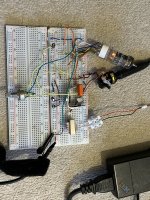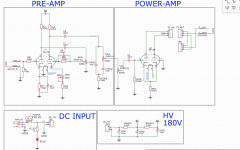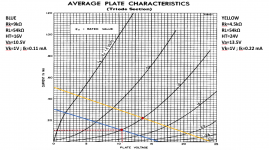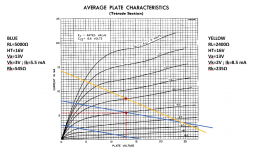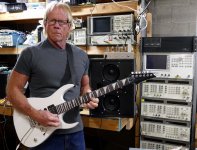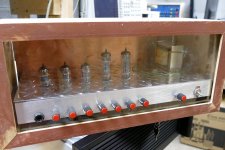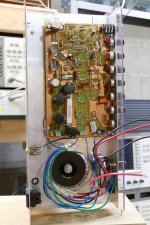Hi,
I would like to give a try in designing a guitar amp using a low voltage valve.
I bought a 12dy8 but the datasheet doesn't state the maximum power. The same applies to many other low voltage valves.
To me should be max voltage x max current.
Can anyone help me with this,please?
Thanks in advance.
Cheers
Pedro
I would like to give a try in designing a guitar amp using a low voltage valve.
I bought a 12dy8 but the datasheet doesn't state the maximum power. The same applies to many other low voltage valves.
To me should be max voltage x max current.
Can anyone help me with this,please?
Thanks in advance.
Cheers
Pedro
I am still deciding, but it seems better to go with 24V to have more headroom.Pedrito, don't expect large power from them. Will you run at 12 or 24/28VDC?
First try will be with 12V though.
12DY8 seems to be designed for relay driver. Roughly speaking, 12V × 14mA = 168mW. But class A efficiency is under 50% so 70 to 80mW is to be expected.
It should be enough to connect headphones to it.
I have a tiny transformer that is 1200:8. Since my headphones are 32ohm, the valve will see 4800, which should be OK.
However, driving a 12'' speaker should be difficult.
I have a tiny transformer that is 1200:8. Since my headphones are 32ohm, the valve will see 4800, which should be OK.
However, driving a 12'' speaker should be difficult.
12AL8 is a space charge triode, note that screen is between cathode and grid: different order than normal tetrodes and pentodes.
I bought the 12DY8 because it was dirty cheap.
The tetrode curves are very non-linear, which will add up to the distortion.
Maybe I will buy a 12AL8 and a 12U7.
Let's see.
The tetrode curves are very non-linear, which will add up to the distortion.
Maybe I will buy a 12AL8 and a 12U7.
Let's see.
Hi
After some time, I did the amp on a breadboard. Connecting it to an Eminence 12'' driver it is very quiet. Just a tad louder than my strumming.
I tested it with several output transformers, but I want to use this cute little thing.
I believe if I try to connect it to a smaller speaker driver will sound louder.
Anyways, great fun building this.
I am planning on doing an YouTube video showing how to do this from specs to the PCB and test the final product.
Then I will distribute all the files to anyone who wants to build one.
Cheers
Pedro
After some time, I did the amp on a breadboard. Connecting it to an Eminence 12'' driver it is very quiet. Just a tad louder than my strumming.
I tested it with several output transformers, but I want to use this cute little thing.
I believe if I try to connect it to a smaller speaker driver will sound louder.
Anyways, great fun building this.
I am planning on doing an YouTube video showing how to do this from specs to the PCB and test the final product.
Then I will distribute all the files to anyone who wants to build one.
Cheers
Pedro
Attachments
Several users have speculated that a 12U7 is just a 12AU7 that was tested for operation at low voltages. Some of my experiments many years ago tend to agree. If you have any 12AU7's, try them before spending money on a 12U7.Maybe I will buy a 12AL8 and a 12U7.
Let's see.
The tubes found in 12 volt car radios rely on a dense "space charge" cloud to create usable current flow with 12 volts on the plate. Generating a dense electron cloud generally requires a large hot cathode which requires a lot of heater current. Often the space charge grid current is higher than the plate current. The most powerful 12 volt radio tube I ever ran across was the 12K5. It needs 450 mA at 12 volts (5.67 watts) for the heater, and another 85 mA for the space charge grid just to make 8 mA of plate current for 35 milliwatts of power into an 800 ohm OPT. These tubes are not terribly linear, so some distortion will be present at any output level.
One could also use one of the 6W6 derivatives wired as a triode in a low voltage application. These do require even more heater power (7.5 watts) but come in lots of different sizes and heater voltages. You can get about the same power with a bit lower distortion, and a couple watts if a higher plate voltage is used. These tubes are all derivatives of the 6W6. 12W6, 12L6, 25L6, 25W6, 50L6, 50B5, 12C5, 17C5, 25C5, 50C5, 6CU5, 6GC5,6DG6GT, 6DB5 and 12DB5. All of these have the same curves.
If you want speaker power from a low voltage source, look at tubes designed for aircraft or marine use at 26 or 28 volts. The 16A7 (octal) or 28D7 (loktal) can give you half a watt from 26 to 28 volts. There are two pentodes in each bottle, so only one tube is needed for a push pull amp.
About 15 years ago I set out to build a vacuum tube guitar amp that was small enough to fit inside the body of an electric guitar. I wanted enough power to drive a small speaker that was also mounted in the guitar body. I also needed a low overall power consumption to allow for operation from a 7.2 volt battery pack from an RC model car that was stuffed into the area where the whammy bar springs go on a Strat clone body. This ruled out hungry space charge tubes and anything bigger than a 7 pin miniature tube.
I made a small step up converter to give me about 100 to 175 volts from that 7.2 volt battery. These things can be bought ready made from China today. I found two possible choices for output tubes that could generate about 1 watt in SE and 3 watts in push pull. The 6AK6 is a 7 pin miniature tube in a short bottle. It needs 150 to 175 volts to give you 1 watt in SE and a pair in push pull will make almost 4 watts in "full metal racket" mode. They have a 0.95 watt heater and are common on the surplus market. The 5902 is a small subminiature tube that will give you a watt in SE from about 100 volts, but they are hard to find, and they have a 2.84 watt heater so they are somewhat hungry.
I wound up building two different breadboarded amps, but neither ever made their way into a guitar. One was a two tube 5C1 champ style using a 5899 subminiature pentode tube driving a 6AK6 for about 1 watt of power. It consumed about 4 watts of power at full output. The other used a 6122 subminiature dual triode, a mosfet PI, and two 6AK6's in push pull. It consumed about 12 watts of power at full crank but screamed like a shrunken Marshall when fed with a germanium Fuzz Face clone. Those 8 pin subminiature tubes can be made to fit into an 8 pin socket designed for an 8 pin round OPAMP chip.
@Tubelab_com intetesting data for me too. I have two subminiature 95108 pentodes designed for radiosondes, from about 5 years ago when a guy gift me them. My future plans for them are to make a portable regenerative receiver to listen AM while bikeing. My idea was to use NiCd or NiMH batteries to give 12 or 24V for anode. The screen grid used to control the regeneration and make a small autotransformer as anode load to fit 32ohms earphones.
ECL80 is an alternative to 6AK6 for a battery operated amplifier with DC-DC step-up converter. For true low voltage operation, @Tubelab_com suggestion about the 6W6 derivative is a good one. 6L6 also works at low voltage, this was a well known fact also referenced by an article on may 1945 issue of Radio Craft. A few TV sweep tubes such as EL504 / PL504 / EL36 also works at low voltage - they are tubes with very big cathode. There is an interesting article about the 12K5 design at page 47 of the january 1957 Radio News issue, available at worldradiohistory website. The author was a Tung-Sol designer and describes first hand experiences on this uncommon operation mode. Another useful reference is the "Triodes at Low Voltages - Linear amplifiers under starved conditions" article by Merlin Blencowe at valvewizard web site. Further useful information can be read from US patent 10063194 by Ronald Quan - this is basically the same content of the Linear Audio magazine article.
Another option is to increase the voltage to 50V. This is still a safe voltage and a traditional standard for telecomunications equipment. Due to the increasing popularity of power over ethernet technology, 50V switching power supplies are now cheap and readily available. 50V is also the filament supply required by several sweep tubes, and there is a tested design by the forum member Pilovis that works at 60V.
Another option is to increase the voltage to 50V. This is still a safe voltage and a traditional standard for telecomunications equipment. Due to the increasing popularity of power over ethernet technology, 50V switching power supplies are now cheap and readily available. 50V is also the filament supply required by several sweep tubes, and there is a tested design by the forum member Pilovis that works at 60V.
Usually a larger speaker is more efficient. An Eight-12" Full Stack can shake the house with flea-power. (Or a full stadium with the 100W head.)I believe if I try to connect it to a smaller speaker driver will sound louder.
No. Nothing is 100% in to out. Also we test with sine-waves, not switch-mode. An audio pentode is maybe 40% from DC input power to sine audio. But this 12DY8 is a relay driver. Not a terrible audio device but 12V is VERY small for electrons in a vacuum. They don't want to leave the metal electrodes.the datasheet doesn't state the maximum power. The same applies to many other low voltage valves.
To me should be max voltage x max current.
There is another old Cadillac radio tube which makes 40mW at gross THD and 600r load.
Last edited:
Wow guys.
Thanks for the detailed answers.
For low voltage operation and low filament current please check the Russian rod pentodes here:
http://www.radicalvalves.com/russian/russian-rod-pentodes-1/
The 1j24b has 13mA of heater current.
@PRR Many years ago, I have tried two JAMO speakers with identical specs in my home hi-fi. One pair was 90W and the other 120W. I have ended up buying the 90W because they sounded louder and punchier.
I believe that asking the 12DY8 to move a 12'' cone is a bit too much.
I have tried, last year, a 4.5'' woofer removed from a logitec PC speaker set and they sounded louder than the 12'' too.
@pcan I don't have an ECL80 but I do have an ECF80 and a pair of ECL84.
Regarding subminiature tubes we have the 6P30B-R which is a 6W power.
Cheers,
Pedro
Thanks for the detailed answers.
For low voltage operation and low filament current please check the Russian rod pentodes here:
http://www.radicalvalves.com/russian/russian-rod-pentodes-1/
The 1j24b has 13mA of heater current.
@PRR Many years ago, I have tried two JAMO speakers with identical specs in my home hi-fi. One pair was 90W and the other 120W. I have ended up buying the 90W because they sounded louder and punchier.
I believe that asking the 12DY8 to move a 12'' cone is a bit too much.
I have tried, last year, a 4.5'' woofer removed from a logitec PC speaker set and they sounded louder than the 12'' too.
@pcan I don't have an ECL80 but I do have an ECF80 and a pair of ECL84.
Regarding subminiature tubes we have the 6P30B-R which is a 6W power.
Cheers,
Pedro
I have never used any of the Russian rod tubes, but I have experimented with some very low current / voltage US made DH subminiature pentode tubes like the 6418, 5678, and 6088. These were intended for hearing aids and other small amplifiers. The 6088 is the largest with a 1.25 volt 20 mA filament, and a power output spec of 10 milliwatts. The 6418 has a 1.25 volt 10 mA filament and is rated for 2.2 milliwatts of output power. The 5678 is intended for voltage amplifier (preamp tube) but it has the biggest filament, 1.25 volts 50 mA.
Why does a voltage amp tube need the thickest filament when it does not need the excess emission to make power output? The answer is "microphonics." The filament of the 6418 is thinner than a human hair. It will pick up the slightest vibration and amplify it just like the diaphragm in a microphone. Some 6418's are known to "sing," generating a high pitched tone all by themselves. They will literally pick up the vibrations from the strings when mounted in a guitar with no connection to the guitar's pickup or create large amounts of feedback if placed near the speaker.
The other tubes mentioned also exhibit microphonic effects, but are not as bad as the 6418. I don't know anything about the Russian rod tubes, but anything with a long thin filament will likely have the same issues.
Why does a voltage amp tube need the thickest filament when it does not need the excess emission to make power output? The answer is "microphonics." The filament of the 6418 is thinner than a human hair. It will pick up the slightest vibration and amplify it just like the diaphragm in a microphone. Some 6418's are known to "sing," generating a high pitched tone all by themselves. They will literally pick up the vibrations from the strings when mounted in a guitar with no connection to the guitar's pickup or create large amounts of feedback if placed near the speaker.
The other tubes mentioned also exhibit microphonic effects, but are not as bad as the 6418. I don't know anything about the Russian rod tubes, but anything with a long thin filament will likely have the same issues.
@Tubelab_com
Thanks for your comment.
Russian rod pentodes were used in hearing aids too. I just looked at the russian tubes since they are dirty cheap. A lot of 10 can cost something between £1.5 to £2 and in lots of 20 £1 - £1.5.
Then we have a special one which is the 1P24B. This one is a 3W output pentode and costs peanuts. So, we can do very low cost low power amps.
Actually, I was thinking of using them to make a Marshall Plexi replica, that could run on batteries. 🙂
Thanks for your comment.
Russian rod pentodes were used in hearing aids too. I just looked at the russian tubes since they are dirty cheap. A lot of 10 can cost something between £1.5 to £2 and in lots of 20 £1 - £1.5.
Then we have a special one which is the 1P24B. This one is a 3W output pentode and costs peanuts. So, we can do very low cost low power amps.
Actually, I was thinking of using them to make a Marshall Plexi replica, that could run on batteries. 🙂
If you haven't seen it already this thread is full of lots of information related to small guitar amp design and building.
https://www.diyaudio.com/community/threads/the-hundred-buck-amp-challenge.190738/
I made three amps for this challenge though personal situations prevented any of them from being completely finished. There was a 4 tube design that cost under $50 at the time and met the "no semiconductors" requirement that got imposed early in the thread's development. It however didn't go to 11, so it didn't get much real use.
After the challenge had ended the person who provided the spark for the challenge, and demanded the no semiconductors rule had left, and the thread went dark for about 6 months. By 2016 I had lost my job and moved 1200 miles and began unpacking boxes from the move when I found the remnants of the old 4 tube amp. With nobody to enforce the rules I woke up the old thread and turned the little 4 tube amp into a screamer that still gets used today. That amp has a gain knob that goes way past 11, past SLO100, and into total chaos, and does this with only 4 watts of power. The thread reboot starts with post #1605 with scattered posts from there to the end. The schematic for the 4 tube screamer is included here. The X-2 terminals go to the isolation transformer for about 125 volts. X-3 is the OPT which is a 300-040 line transformer from Parts Express. The amp still has no case, but is seen here on top of a speaker cabinet. The dead remains of its predecessor is seen to the right of my left ear on top of the HP spectrum analyzer.
Amp 2.0 the 18W Marshall inspired heavy hitter has been found, but I haven't finished it since I don't really need it.
https://www.diyaudio.com/community/threads/the-hundred-buck-amp-challenge.190738/
I made three amps for this challenge though personal situations prevented any of them from being completely finished. There was a 4 tube design that cost under $50 at the time and met the "no semiconductors" requirement that got imposed early in the thread's development. It however didn't go to 11, so it didn't get much real use.
After the challenge had ended the person who provided the spark for the challenge, and demanded the no semiconductors rule had left, and the thread went dark for about 6 months. By 2016 I had lost my job and moved 1200 miles and began unpacking boxes from the move when I found the remnants of the old 4 tube amp. With nobody to enforce the rules I woke up the old thread and turned the little 4 tube amp into a screamer that still gets used today. That amp has a gain knob that goes way past 11, past SLO100, and into total chaos, and does this with only 4 watts of power. The thread reboot starts with post #1605 with scattered posts from there to the end. The schematic for the 4 tube screamer is included here. The X-2 terminals go to the isolation transformer for about 125 volts. X-3 is the OPT which is a 300-040 line transformer from Parts Express. The amp still has no case, but is seen here on top of a speaker cabinet. The dead remains of its predecessor is seen to the right of my left ear on top of the HP spectrum analyzer.
Amp 2.0 the 18W Marshall inspired heavy hitter has been found, but I haven't finished it since I don't really need it.
Attachments
- Home
- Amplifiers
- Tubes / Valves
- Car radio valves 12AL8, 12DY8 max power
